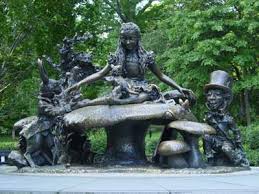 Alice's Adventures in Wonderland is an 1865 novel written by English author Charles Lutwidge Dodgson under the pseudonym Lewis Carroll.
Alice's Adventures in Wonderland is an 1865 novel written by English author Charles Lutwidge Dodgson under the pseudonym Lewis Carroll.
It tells the story of a girl named Alice who falls down a rabbit hole into a fantasy world populated by peculiar creatures. Its narrative course and structure, characters and imagery have been enormously influential in both popular culture and literature, especially in the fantasy genre.
It is told in the form of a DREAM and Carroll uses the third person point of view because in this way he was free to make fun of and satirize the standard Victorian didactic ideas.
In fact, this book inaugurated a new era of children's literature in English: books that didn't have to be didactic or moralistic, that didn't teach children lessons. Alice in Wonderland and its sequel Through the Looking Glass paved the way for many books such as The SpiderWick Chronicles , Harry Potter series, Narnia Chronicles and so on.
In this book rationality is replaced by the bizarre, everything is unpredictable and disordered. What makes the story more fun is that Alice tries to apply all her previous "adult" knowledge from the "above world" to the new "under world" she is in and obviously it doesn´t make any sense...
Wonderland is a magic place. Everyone feels free there but it is also a place of bad dreams.It is a fairy land where the Cheschire Cat lives and continuously appears an disappears, where the Mad Hatter moves around and the place where the Queen of Hearts and her knaves set their own mad and illogical rules. Animals speak and complain as if they were adults. It is the place where Alice changes sizes several times and where languages loses its logic and its power to communicate. Wonderland is a chaos, but a lovely one!!!
In the pictures below you can see some of the most famous characters in Wonderland: the White Rabbit, the Dormouse, the Mad Hatter, the Hare, The Cheshire Cat, the Carterpillar, the Queen of Hearts, etc. Let´s describe and compare them and after reading the book do you remember where do they exactly appear in the story? Do you have a favourite one? Why?
In the book there are many recurrent topics:
- growth into adulthood
- games and learning the rules
- language, logic and absurd language.
- Size changes.
- Surrealism
- Dreams and nightmares
Can you find any of these ideas in the version we have read in class?
Where? Explain the ones you can see and look for examples from the book.
Here you have some famous quotations from the original book, they can help you find the themes suggested above.
Alice. What is the use of a book, without pictures or conversations?
Alice Curiouser and curiouser!
Alice I wonder if I've been changed think. Was I the same when I got up this morning? I almost think I can remember feeling a little different. But if I'm not the same, the next question is 'Who in the world am I?' Ah, that's the great puzzle!
Alice I can't explain myself, I'm afraid, Sir, because I'm not myself you see.
Alice If it had grown up, it would have made a dreadfully ugly child; but it makes rather a handsome pig, I think.
The Cat We're all mad here.
The Hatter Why is a raven like a writing desk?
The Hatter Twinkle, twinkle, little bat! How I wonder what you're at.
The Queen Off with her head!
The Queen Sentence first -- verdict afterwards.
Alice But then, shall I never get any older than I am now? That'll be a comfort, one way -- never to be an old woman -- but then -- always to have lessons to learn!
Doorknob Read the directions and directly you will be directed in the right direction.
Mad Hatter No wonder you're late. Why, this watch is exactly two days slow.
In the book we have some
nursery rhymes and songs. For example:
The Queen of Hearts she made some tarts all on a summer's day;
The Knave of Hearts he stole the tarts and took them clean away.
The King of Heartscalled for the tarts and beat the Knave full sore
The Knave of Hearts brought back the tarts and
vowed he'd steal no more.
 In Central Park East 74th Street in New York we can see a beautiful sculpture of Alice and her friends. Click on the link and listen
In Central Park East 74th Street in New York we can see a beautiful sculpture of Alice and her friends. Click on the link and listen to this person talking about it and explaining why she likes it. Alice´s sculpture in Central Park
to this person talking about it and explaining why she likes it. Alice´s sculpture in Central Park
1. In which part of Central Park can you find the statue?
2. Which material is it made of?
3. How high is the sculpture?
4. Who is with Alice in the sculpture?
5. How is her hair held?
6. Where is the dormouse?
7. Why is the sculpture very nice for children?
8. Why is the big mushroom nice for little children to have a rest?
If you feel like reading and listening to the full story here you have the following audio book.


